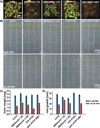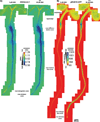Abscisic acid and other plant hormones: Methods to visualize distribution and signaling
- PMID: 26577078
- PMCID: PMC4677054
- DOI: 10.1002/bies.201500115
Abscisic acid and other plant hormones: Methods to visualize distribution and signaling
Abstract
The exploration of plant behavior on a cellular scale in a minimal invasive manner is key to understanding plant adaptations to their environment. Plant hormones regulate multiple aspects of growth and development and mediate environmental responses to ensure a successful life cycle. To monitor the dynamics of plant hormone actions in intact tissue, we need qualitative and quantitative tools with high temporal and spatial resolution. Here, we describe a set of biological instruments (reporters) for the analysis of the distribution and signaling of various plant hormones. Furthermore, we provide examples of their utility for gaining novel insights into plant hormone action with a deeper focus on the drought hormone abscisic acid.
Keywords: abscisic acid; fluorescent reporter; in vivo visualization; plant hormone.
© 2015 WILEY Periodicals, Inc.
Conflict of interest statement
The authors have declared no conflicts of interest.
Figures




Similar articles
-
Balancing growth and adaptation to stress: Crosstalk between brassinosteroid and abscisic acid signaling.Plant Cell Environ. 2020 Oct;43(10):2325-2335. doi: 10.1111/pce.13846. Epub 2020 Aug 31. Plant Cell Environ. 2020. PMID: 32671865 Review.
-
Plant hormone-mediated regulation of stress responses.BMC Plant Biol. 2016 Apr 14;16:86. doi: 10.1186/s12870-016-0771-y. BMC Plant Biol. 2016. PMID: 27079791 Free PMC article. Review.
-
Mechanisms of abscisic acid-mediated control of stomatal aperture.Curr Opin Plant Biol. 2015 Dec;28:154-62. doi: 10.1016/j.pbi.2015.10.010. Epub 2015 Nov 19. Curr Opin Plant Biol. 2015. PMID: 26599955 Free PMC article. Review.
-
Turning on gibberellin and abscisic acid signaling.Curr Opin Plant Biol. 2006 Oct;9(5):454-9. doi: 10.1016/j.pbi.2006.07.007. Epub 2006 Jul 25. Curr Opin Plant Biol. 2006. PMID: 16870490 Review.
-
Hormone signaling pathways under stress combinations.Plant Signal Behav. 2016 Nov;11(11):e1247139. doi: 10.1080/15592324.2016.1247139. Plant Signal Behav. 2016. PMID: 27739927 Free PMC article.
Cited by
-
Antagonistic Regulation of ABA and GA in Metabolism and Signaling Pathways.Front Plant Sci. 2018 Feb 26;9:251. doi: 10.3389/fpls.2018.00251. eCollection 2018. Front Plant Sci. 2018. PMID: 29535756 Free PMC article. Review.
-
Plant-Microbe Interactions under the Extreme Habitats and Their Potential Applications.Microorganisms. 2024 Feb 22;12(3):448. doi: 10.3390/microorganisms12030448. Microorganisms. 2024. PMID: 38543499 Free PMC article. Review.
-
Dual-Reporting Transcriptionally Linked Genetically Encoded Fluorescent Indicators Resolve the Spatiotemporal Coordination of Cytosolic Abscisic Acid and Second Messenger Dynamics in Arabidopsis.Plant Cell. 2020 Aug;32(8):2582-2601. doi: 10.1105/tpc.19.00892. Epub 2020 May 29. Plant Cell. 2020. PMID: 32471862 Free PMC article.
-
RGB Imaging as a Tool for Remote Sensing of Characteristics of Terrestrial Plants: A Review.Plants (Basel). 2024 Apr 30;13(9):1262. doi: 10.3390/plants13091262. Plants (Basel). 2024. PMID: 38732477 Free PMC article. Review.
-
Signaling mechanisms in abscisic acid-mediated stomatal closure.Plant J. 2021 Jan;105(2):307-321. doi: 10.1111/tpj.15067. Epub 2020 Dec 9. Plant J. 2021. PMID: 33145840 Free PMC article. Review.
References
-
- Cutler SR, Rodriguez PL, Finkelstein RR, Abrams SR. Abscisic acid: emergence of a core signaling network. Annu Rev Plant Biol. 2010;61:651–679. - PubMed
-
- Peer WA. From perception to attenuation: auxin signalling and responses. Curr Opin Plant Biol. 2013;16:561–568. - PubMed
-
- Kim TW, Wang ZY. Brassinosteroid signal transduction from receptor kinases to transcription factors. Annu Rev Plant Biol. 2010;61:681–704. - PubMed
Publication types
MeSH terms
Substances
Grants and funding
LinkOut - more resources
Full Text Sources
Other Literature Sources

